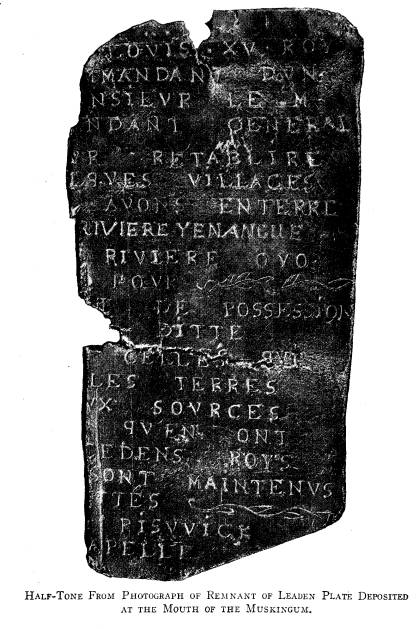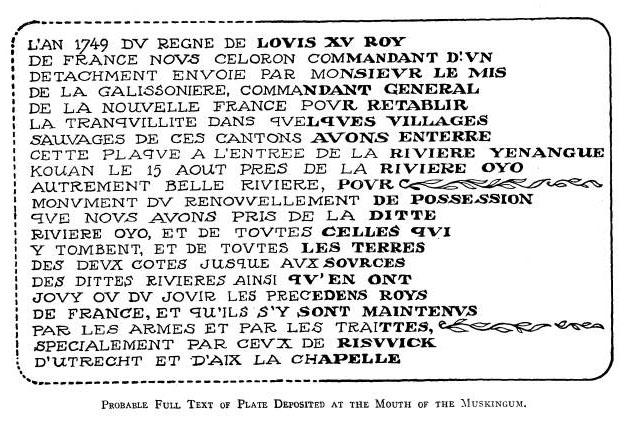Ohio History Journal
LEADEN PLATE AT
THE MOUTH OF THE MUSKINGUM
In the October QUARTERLY were published
cuts of the
leaden plate prepared for deposit at the
mouth of the Conewango
and the one buried at the mouth of the
Kanawha.
On the following pages are illustrations
of the remnant of
the plate buried at the mouth of the
Muskingum and what was
probably its entire text. This plate was
considerably multilated.
A portion of the lead was cut away for
bullets before the signifi-
cance and importance of this relic were
realized. We are under
obligation to the American Antiquarian
Society for a very satis-
factory photograph of this remnant from
which has been pro-
duced the illustration on the following
page.
The plates which have been found thus
far show that an
effort was made to include identical
text on each with the excep-
tion of the date and the name of the
river at the mouth of which
the plate was buried. No two of the
plates, however, could have
been made from the same mold, as they
contain respectively
nineteen, twenty-one and eighteen lines
of varying length. A
separate mold must have been used in
casting each and space
was left to engrave the date and the
name of the river, at the
confluence of which with the Ohio, each
plate was buried. Some
writers have ventured the opinion that
the inscription, with the
exception above noted, was stamped upon
the plates.
The full text of the inscription on the
plate buried at the
mouth of the Muskingum is not given in
either of the Journals,
but from the official statement, the
text of the inscriptions on
the other plates and the assertion of
Celoron that "the inscription
is always the same" (page 371) the
writer has undertaken to
supply, with the aid of the fragment
left, the full inscription of
this plate. The result is found on page
479. It cannot vary
materially from the original and is
believed to be practically
identical with it.
A comparison of the texts of these
plates shows some varia-
tions and slight inaccuracies in
orthography. The artist, Paul
(477)
|
478 Ohio Arch. and Hist. Society Publications. |
|
|
|
Leaden Plate at the Mouth of the Muskingum. 479 |
480 Ohio Arch. and Hist. Society Publications.
de Brosse, like Celoron himself, had
evidently not taken first
prize in spelling words of his native
tongue and was somewhat
careless as the variations in the texts
of the inscriptions indicate.
Mr. Marshall in his paper, page 442,
tells us how Caleb Atwater,
Governor Clinton and others were led for
years to suppose that
the leaden plate found at the mouth of
the Muskingum had
originally been buried at the mouth of
French Creek on the
site of the old Indian village, Venango.
They were led to this
conclusion by the similarity of the
words "Yenangue" and
"Venango." The fact is, as the
Journal of Celoron shows, that
"Yenangue" is only part of the
name of the river, the con-
cluding portion of which, "kouan"
undoubtedly was carried over
to the beginning of the next line,
completing the word "Yenan-
guekouan" the name given to what is
now the Muskingum
River.
The circumstances under which this plate
was discovered
are stated on a succeeding page and more
fully in Hildreth's
Pioneer History of the Ohio Valley pages 19 and 20. The
names of the boys who discovered the
plate are not given. In
The Olden Time, Vol i, pages 238-241, is published an account
of the discovery of the plate at the
mouth of the Great Kanawha.
This plate was found by "a little
son of J. W. Beale, while play-
ing on the margin of the river."
The writer in The Olden Time
makes the following comment on the
inscription of this plate:
"The French is none of the purest,
and the accents, apos-
trophies, and punctuation are wanting,
except that the circum-
flex is placed over the initial O in Oyo
the first time that word
occurs, while the I's, though capitals,
are invariably dotted, and
the Q's are of the old black letter
form, like a P reversed."

